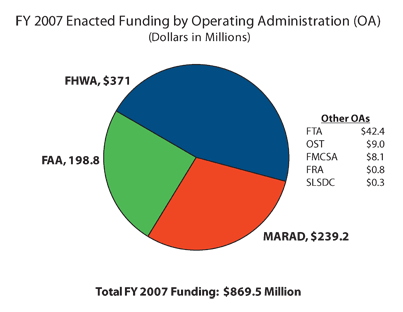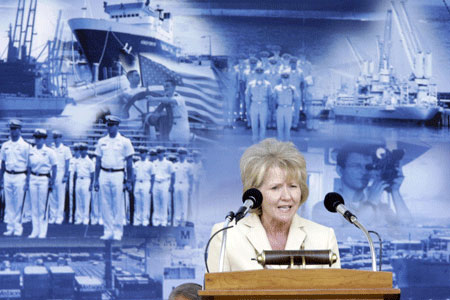 PERFORMANCE REPORT
PERFORMANCE REPORT

STRATEGIC OUTCOMES
PERFORMANCE MEASURES
 U.S. Secretary of Transportation Mary E. Peters addresses the Merchant Marine Academy graduation ceremony, Monday, June 18, 2007 in Kings Point, New York. (AP Photo/Mary Altaffer)
U.S. Secretary of Transportation Mary E. Peters addresses the Merchant Marine Academy graduation ceremony, Monday, June 18, 2007 in Kings Point, New York. (AP Photo/Mary Altaffer)
The Department of Defense (DOD) relies on the U.S. commercial transportation industry as well as government-owned ships to deliver equipment and supplies throughout the world in order to maximize defense logistics capabilities and minimize cost. The availability of shipping capacity is determined by a number of different factors: availability of commercial vessels, availability of government-owned sealift vessels, availability of qualified mariners to crew these vessels, and the availability of war risk insurance coverage for vessels entering a war zone. All of these factors must be managed properly in order to support DOD's mobilization requirements.
The Department's Maritime Security Program (MSP) ensures that the United States will have U.S.-flag commercial vessels along with their intermodal assets to support DOD operations. DOD also uses Voluntary Intermodal Sealift Agreements (VISA) with commercial carriers to pre-plan the availability of militarily useful U.S.-flag merchant vessels for emergency sealift support. All ships enrolled in VISAs commit certain percentages of their vessel capacity and use of their related intermodal transportation resources to DOD.
The DOT-owned Ready Reserve Force (RRF) is also a very important component of the Department's ability to provide sealift capacity in times of emergency to DOD. These ships also serve as an important asset supporting the Department's emergency preparedness and disaster response activities. The RRF is composed of 44 ships with special capabilities that can carry or offload heavy and oversized military cargoes which regular U.S.-flag commercial cargo ships cannot carry. RRF ships meet approximately half of the U.S. Transportation Command's surge (or initial) sealift requirement during a mobilization.
Ship capacity, both commercial and government-owned, is only one part of the mobilization equation. These ships must be operated by skilled crews. The Maritime Administration supports the training of new merchant marine officers by operating the U.S. Merchant Marine Academy (USMMA) and by providing funding and training vessels to support the six State Maritime Schools (SMS). The USMMA and SMSs are the principal source of new unlimited license merchant marine officers. Licensed mariners are needed by DOD during national emergencies not only for crewing purposes, but also to provide shore- side support for sealift operations.
In order to enter war zones, commercial vessels require specific war risk insurance binders. The Maritime Administration issues these binders because regular commercial marine insurance will not cover losses resulting from war or warlike actions. Without this program, the DOD could not rely on commercial ships for sealift during an emergency.
DOT, through the Maritime Administration, is also responsible for establishing DOD's prioritized use of facilities at 15 U.S. commercial strategic ports during DOD mobilizations to ensure the safe, secure, and smooth flow of military cargo through the commercial U.S. transportation system while minimizing commercial cargo disruptions.
2007 Results - DOT exceeded the 2007 performance target. The Maritime Administration achieved these results through the successful pursuit of a number of activities. Most significantly, to assure sufficient availability of U.S. ships, the Maritime Administration maintained full enrollment in the Maritime Security Program, stable enrollment in the Voluntary Intermodal Sealift Agreement program and Ready Reserve Force readiness levels. The Maritime Administration successfully operated the War Risk Insurance program, which ensured U.S. commercial ships could enter the Middle East war zones to sustain U.S. activities in Iraq and Afghanistan.
In the interest of ensuring that sufficient numbers of highly qualified new mariners enter the U.S. workforce, Maritime Administration supported training activities resulted in the graduation of 187 U.S. citizen, unlimited license ship officers from the USMMA in June 2007 and 479 from the six State Maritime Schools.
Taken together, the above activities as well as those undertaken to assure the availability of strategic ports (discussed below), ensure the smooth and secure movement of deploying DOD personnel and material from origin to destination and support the Department's ability to rapidly support response and recovery efforts for domestic and international emergencies.
Performance Measure Percentage of DOD-required shipping capacity complete with crews |
||||
| 2004 | 2005 | 2006 | 2007 | |
|---|---|---|---|---|
| Target | 94 | 94 | 94 | 94 |
| Actual | 94 | 95 | 93 | 97 |
| Associated FY 2007 Funding - $ 238 million | ||||
FY 2008 Performance Forecast - The Maritime Administration expects to meet the FY 2008 target.
2007 Results - DOT exceeded the 2007 performance target. A number of activities during 2007 led to this result. The Maritime Administration participated in joint military mobilization and security exercises as well as strengthened the cooperative partnerships that ensure effective emergency planning and coordination with a variety of organizations. The Agency also administered an Intelligent Transportation System Deployment Integration program with PAR Government Systems Corporation that demonstrated container and chassis satellite tracking technology using the PAR Cargo Watch System. PAR technology has evolved from cellular to satellite technology and into the cold food supply chain market. PAR successfully tracked 51 USTRANSCOM containers of ammunition and explosives from Korea to U.S. ammunition depots.
Performance Measure Percentage of DOD-designated commercial parts available for military use |
||||
| 2004 | 2005 | 2006 | 2007 | |
|---|---|---|---|---|
| Target | 92 | 93 | 93 | 93 |
| Actual | 93 | 87 | 100 | 100 |
| Associated FY 2007 Funding - $ 874 thousand | ||||
FY 2008 Performance Forecast - The Maritime Administration expects to meet the FY 2008 target.
The past year marked an increase in the workload of intelligence operations and clarifications in the role for disaster preparedness and response for the DOT Office of Intelligence, Security, and Emergency Response. One new intelligence initiative has been information sharing and DOT has made significant progress in this initiative at the Federal Bureau of Investigations (FBI) National Joint Terrorism Task Force. The DOT representative to the National Joint Terrorism Task Force provides information to the other task force members and obtains information that impacts DOT, transportation infrastructure, transportation systems and their operations.
Along with its work in intelligence, DOT continued to ensure readiness to undertake its role as defined in the National Response Plan. DOT is the lead agency for coordinating transportation response and support following a disaster and has taken a more active role working with State and local transportation officials in planning for disasters. We are collaboratively assessing transportation infrastructure and systems for vulnerabilities and identifying critical elements. DOT is also working with State and local officials in identifying response options to local transportation failures.
2007 Results - In addition to responses to threats and emergencies, the Department measures internal preparedness using the Transportation Capability Assessment for Readiness (TCAR) score. It assesses six functional areas to obtain the overall TCAR score. These areas include monitoring operations, emergency response, training and exercises, continuity of operations, continuity of government, and international civil emergency planning. DOT was unable to meet its target of 75.
Performance Measure Transportation Capability Assessment for Readiness Index Score. |
||||
| 2004 | 2005 | 2006 | 2007 | |
|---|---|---|---|---|
| Target | N/A | 71 | 72 | 75 |
| Actual | 67 | 65 | 72 | 70 |
| Associated FY 2007 Funding - $ 9 million | ||||
FY 2008 Performance Forecast - In 2008, the Department is planning to expand intelligence support to Operating Administrations, expand our policy development role and work with state and local governments to ensure preparedness and better planning for emergency response operations. We are developing new performance measures for the new Security, Preparedness and Response Strategic Goal-“Balance Transportation security requirements with the safety, mobility, and economic needs of the Nation and be prepared to respond to emergencies that affect the viability of the transportation sector.” During Fiscal Year 2008, we will conduct a trial performance period to field test and calibrate the performance measures.
In-Depth Accomplishments Promoting Transportation ReadinessOver the past year the responsibilities and workload of the Intelligence Division have increased dramatically. The division focused on expanding interagency analytic contacts within the Intelligence Community and by working with intelligence partners, particularly the National Counterterrorism Center and the FBI, in providing information and analysis, which has been used in various products produced by the Interagency Intelligence Committee on Terrorism as well as National Terrorism Bulletins and briefings.
Operational response activities by DOT were at a more normal level than had been experienced in either 2005 or 2006. For a second year, DOT staffed the Joint Field Office in Baton Rouge through the summer to facilitate evacuation planning for south Louisiana.
The Secretaries of DOT and the Department of Homeland Security agreed to transition the transportation contracting function to FEMA by the end of 2007. DOT assisted FEMA by negotiating and transferring the evacuation bus contract, and assisted FEMA in establishing its own contract with Amtrak and its own contracting function.
DOT participated in several major national exercises, including the Ardent Sentry, Rubicon and Pinnacle Exercises. These exercises engaged both senior and operational staff. For example, more than 150 DOT personnel, including the Secretary, Deputy Secretary, and nine other Assistant Secretaries or heads of Operating Administrations, participated in the Pinnacle exercise.